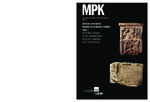Keltische Theonymie, Kulte, interpretatio
X. Workshop F.E.R.C.AN., Paris 24.–26. Mai 2010
| dc.contributor.author | Hofeneder, Andreas | |
| dc.contributor.author | de Bernardo Stempel, Patrizia | |
| dc.date.accessioned | 2013-12-31 23:55:55 | |
| dc.date.accessioned | 2020-02-04 11:50:00 | |
| dc.date.accessioned | 2020-04-01T14:58:56Z | |
| dc.date.available | 2020-04-01T14:58:56Z | |
| dc.date.issued | 2013 | |
| dc.identifier | 451552 | |
| dc.identifier | OCN: 1030813779 | en_US |
| dc.identifier.uri | http://library.oapen.org/handle/20.500.12657/33866 | |
| dc.description.abstract | This tenth volume appearing within the framework of the OEAW interdisciplinary research- project Fontes epigraphici religionum Celticarum antiquarum increases our understanding of several aspects of the religious traditions handed down by Celtic-speaking populations, from Britain and the Iberian Peninsula to ancient Italy and Dacia, all through the Gauls and the Germaniae.This tenth volume appearing within the framework of the OEAW interdisciplinary research- project Fontes epigraphici religionum Celticarum antiquarum increases our understanding of several aspects of the religious traditions handed down by Celtic-speaking populations, from Britain and the Iberian Peninsula to ancient Italy and Dacia, all through the Gauls and the Germaniae. G. Bauchhenss corrects some preconceived notions about iconography; F. Burillo Mozota, J. A. Arenas Esteban and M. P. Burillo Cuadrado investigate the cultural context of an astronomic platform at Segeda; P. Scherrer puts the nautae Parisiaci pillar on a new hermeneutical basis; N. Gavrilović looks for Celtic speakers in Eastern Europe. J. Gorrochategui, M. C. González Rodríguez, P. Lajoye offer partly revised readings of several votive inscriptions and divine names while P. Y. Lambert, B. Rémy, X. Delamarre analyse theonymical epithets in different ways and N. Beck scrutinizes the relationship between deities and ethnics. P. de Bernardo Stempel discusses the transformations to be observed in a provincial pantheon from the first Celtic inscriptions to the latest Roman ones; W. Spickermann questions the continuity between Pre-Roman and Romano-Celtic religion; A. Hofeneder follows the trail of an Old Celtic and later syncretic deity up to the Imperial Roman historical tradition. M. Hainzmann and P. de Bernardo Stempel present – with the help of numerous and easy understandable tables – an innovative systematization of the various syncretic phenomena known as Interpretatio, whose geographic diversity is pointed out by F. Marco Simón. | |
| dc.language | French | |
| dc.language | Spanish; Castilian | |
| dc.language | English | |
| dc.language | German | |
| dc.subject.classification | thema EDItEUR::Q Philosophy and Religion::QR Religion and beliefs | en_US |
| dc.subject.other | Pre-Roman Celtic religion | |
| dc.subject.other | Romano-Celtic religion | |
| dc.subject.other | Epigraphy | |
| dc.subject.other | Archaeology | |
| dc.subject.other | Iconography | |
| dc.subject.other | Interpretatio | |
| dc.subject.other | Keltische Religion in vorrömischer und gallo-römischer Zeit | |
| dc.subject.other | Epigraphik | |
| dc.subject.other | Archäologie | |
| dc.subject.other | Ikonographie | |
| dc.subject.other | Interpretatio | |
| dc.subject.other | Celts | |
| dc.subject.other | Matres and Matronae | |
| dc.title | Keltische Theonymie, Kulte, interpretatio | |
| dc.title.alternative | X. Workshop F.E.R.C.AN., Paris 24.–26. Mai 2010 | |
| dc.type | book | |
| oapen.abstract.otherlanguage | Diese zehnte Buchpublikation im Rahmen des ÖAW-Projekts „Fontes epigraphici religionum Celticarum antiquarum“ vertieft verschiedene Aspekte der religiösen Überlieferung keltischsprechender Bevölkerungen, von Britannien und der Iberischen Halbinsel über Gallien und Germanien bis hin zum alten Italien und Dakien. | |
| oapen.identifier.doi | 10.26530/oapen_451552 | |
| oapen.relation.isPublishedBy | ca6d9b4e-9864-42c7-af46-370561fe314c | |
| oapen.relation.isFundedBy | 26ae1657-c58f-4f1d-a392-585ee75c293e | |
| oapen.collection | Austrian Science Fund (FWF) | |
| oapen.collection | AG Universitätsverlage | |
| oapen.pages | 274 | |
| oapen.grant.number | PUB 87 | |
| oapen.remark.public | Relevant Wikipedia pages: Celts - https://en.wikipedia.org/wiki/Celts; Matres and Matronae - https://en.wikipedia.org/wiki/Matres_and_Matronae | |
| oapen.identifier.ocn | 1030813779 |

